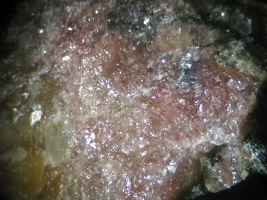
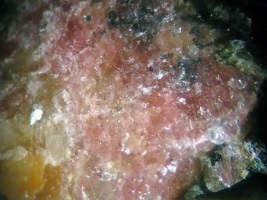
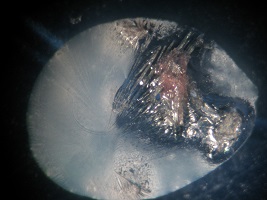
Locality: Palermo Mine, N. Groton, NH
Specimen Size: 1 cm field of view. Two views, lower with polarizers to reduce reflections
Field Collected: Clayton Ford, gift from Gordon Jackson
Catalog No.: u2010
Notes: [tm] This one took multiple tests to arrive at an identification.
I initially thought might be triploidite or triplite. I showed it to Jim Nizamoff .... and he opined "garnet." APFU from a polished grain EDS analysis (BC190 - set 14) gave: Fe2Mn0.70Mg0.17Na0.16O8 Carbon was not quantified. Definitely not a garnet or a phosphate.
I put a grain in a drop of muriatic under my scope. A few bubbles appeared slowly! Since Fe > Mn, I hought perhaps this is Mn rich siderite with a bit of Na and Mg. Just does not look like a carbonate.
In another muriatic grain test 4/3/18 I could not see any bubbles from the pink mineral. A few came from the glassy pale yellow mineral. When the muriatic droplet evaporated overnight, the pink mineral remained, but the pale yellow and dark matrix mineral left behind a clear crystaline residue adjacent to the pink mineral and a white thin crust in the droplet area. - as shown in the third photo.
A second polished grain EDS analysis (BC280) clearly indicated an almandine-spessartine garnet with a chemistry of: (Fe1.61, Mn0.98)Al2.54(SiO4)3. A trace of phosphorous was noted in the analysis.
Jim was right, garnet !
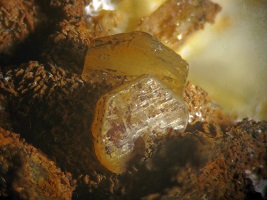
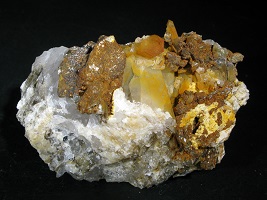
Locality: Rt. 11 Brookside Crossing, Gilford, NH
Specimen Size: 3 mm tabular quartz pseudomorph crystals with quartz crystals on 7 cm specimen
Field Collected: Unknown
Catalog No.: 2053
Notes: Purchased at the 2017 Gilsum Rock swap. I spotted small suspect "apatite" crystals with my eye loupe. At the macro level this specimen is quite pedistrian, perhaps even ugly, with all the rusty limonite. The label just gave the locality, no mineral names, not quartz, not apatite. There also some small black metalic crystals on this piece, perhaps hematite.
No muriatic fizz, so not calcite. A Nov., 2017 EDS analysis showed only Si and O suggesting a quartz pseudomorph after something. An April 2018 retest, (BC281), EDS analysis also confirmed only quartz. Peter Cristofono suggested quartz pseudomorphs after calcite. I think calcite is the best choice for the the pre-pseudomorph mineral.
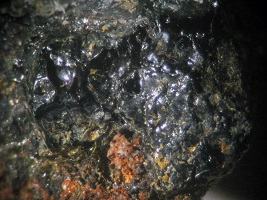
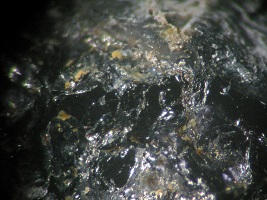
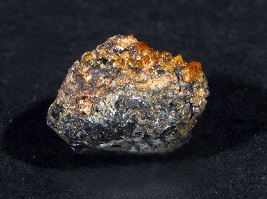
Locality: Bald Mtn., Ossipee, NH
Specimen Size: About 3 mm field of view, top two photos. Lower photo shows overall specimen.
Field Collected: Bob Janules 12/92
Catalog No.: A Bob Janules specimen
Notes: This is the underside of a specimen with the nice monazite-(Ce) and black orthorhombic crystals. It has the conchoidal fracture shown in these photos. A Kerry Day EDS analysis of this mineral gave a result suggesting nioboaeschynite-(Ce).
A Fred Davis review of the weight percent oxides from a May 2018 polished grain EDS analysis (BC282) produced an Ercit plot * indicating this was an aeschynite species. Fred stated that the "data shows a dominance of Ce, so likely aeschynite-(Ce)." He further indicated there was insufficient niobium to be nioboaeschynite-(Ce). "Nioboaeschynite should have >40% Nb-oxide, and aeschynite 23~29%." This specimen analysis Nb weight percent oxide was 23%. Aschynite-(Ce) has been added to The New Hampshire "Rare and Uncommon" gallery.
=====================================
* See article by T. S. Ercit: Canadian Mineralogist Vol. 43 pp. 1291 - 1303 (2005)
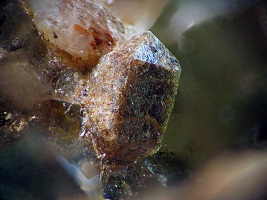
Locality: Knox Mtn., Ossipee, NH
Specimen Size: 1.0 mm zircon crystal
Field Collected: Tom Mortimer
Catalog No.: u264
Notes:
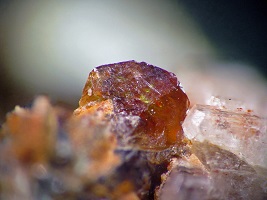
Locality: Knox Mtn., Ossipee, NH
Specimen Size: 0.8 mm monazite-(Ce) crystal
Field Collected: Tom Mortimer
Catalog No.: u264
Notes: Zircon also on this specimen. The Ce species of monazite is assumed but not confirmed.
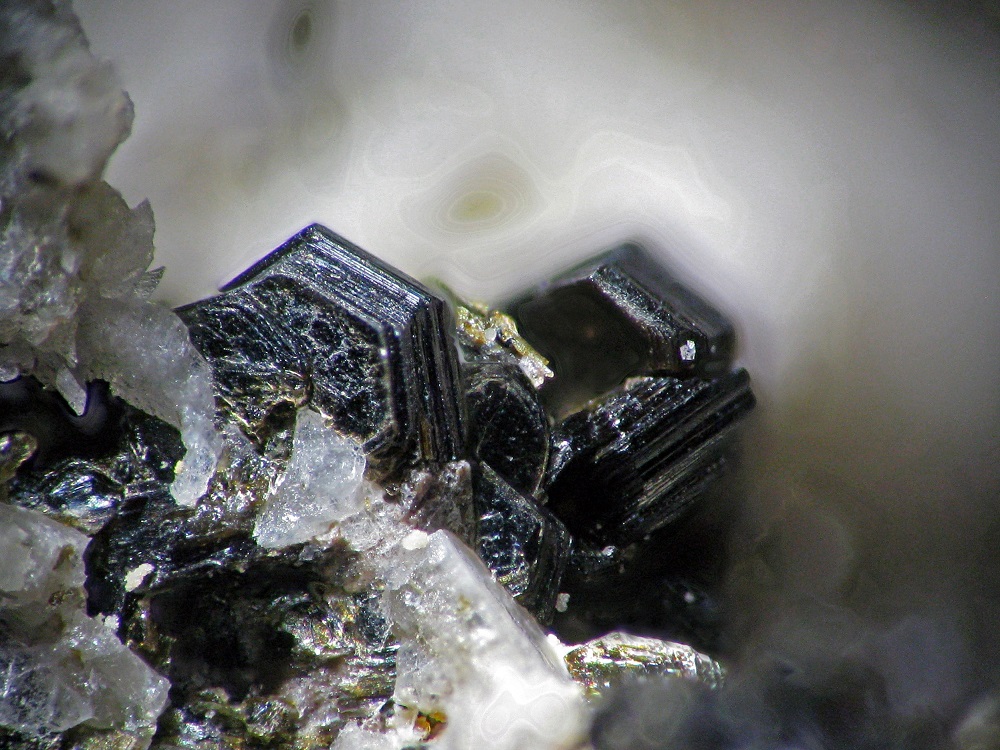
Locality: Ellacoya Locale, Gilford, NH
Specimen Size: Foreground mica crystal is 0.7 mm
Field Collected: Tom Mortimer
Catalog No.: TBC
Notes: This could be one of several dark mica species, but the nice hexagonal form initially suggested annite to me. An April 2018 carbon tape mounted grain EDS analysis (set 19, BC289) indicated a potassium, magnesium dominant (over iron) mica, so this is phlogopite. The chemistry from the analysis gave: (normalized for one atom of potassium)
K(Mg1.6,Fe1.3)Al1.3Si3.6O21.1Cl0.1. This is not too far from the phlogopite - annite midpoint. This is a reasonably satisfying analysis. For a phlogopite - annite mica, the Mg + Fe should add to 3, the Al should be 1 and the Si should be 3
Some greenish foliated balls of mica are also seen at this locality. These are likely a chlorite group species. The chlorite group micas do not have potassium.
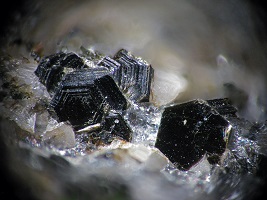
Locality: Ellacoya Locale, Gilford, NH
Specimen Size: 4 mm field of view
Field Collected: Tom Mortimer
Catalog No.: TBC
Notes:

Locality: Mine Ledge, Surry, NH
Specimen Size: 4 mm field of view. Furry goethite balls on quartz.
Field Collected: Tom Mortimer
Catalog No.: u1502
Notes:
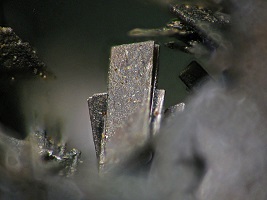
Locality: Mine Ledge, Surry, NH
Specimen Size: 1.5 mm goethite crystal
Field Collected: Tom Mortimer
Catalog No.: u778
Notes: Goethite blade crystals like this are rare.
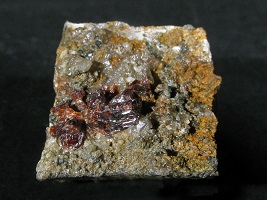
Locality: South side Garnet Hill, Sugar Hill, NH
Specimen Size: 2 cm specimen with subhedral grossular garnet.
Field Collected: Joey Vaughan
Catalog No.: TBC
Notes: Not remarkable as NH garnet specimens go, but I thought this might be the uncommon andradite species which I have confirmed from the Franconia Iron Mine, also in Sugar Hill.
Andradite chemistry is: Ca3Fe3+2(SiO4)3 .
The chemistry of this garnet from EDS analysis is: Ca1.69(Fe1.03,Mn0.20)Al2(SiO4)3 , normalized for two atoms of Al. A calcium garnet with Al > (Fe + Mn) indicates a grossular garnet with a moderate andradite component.